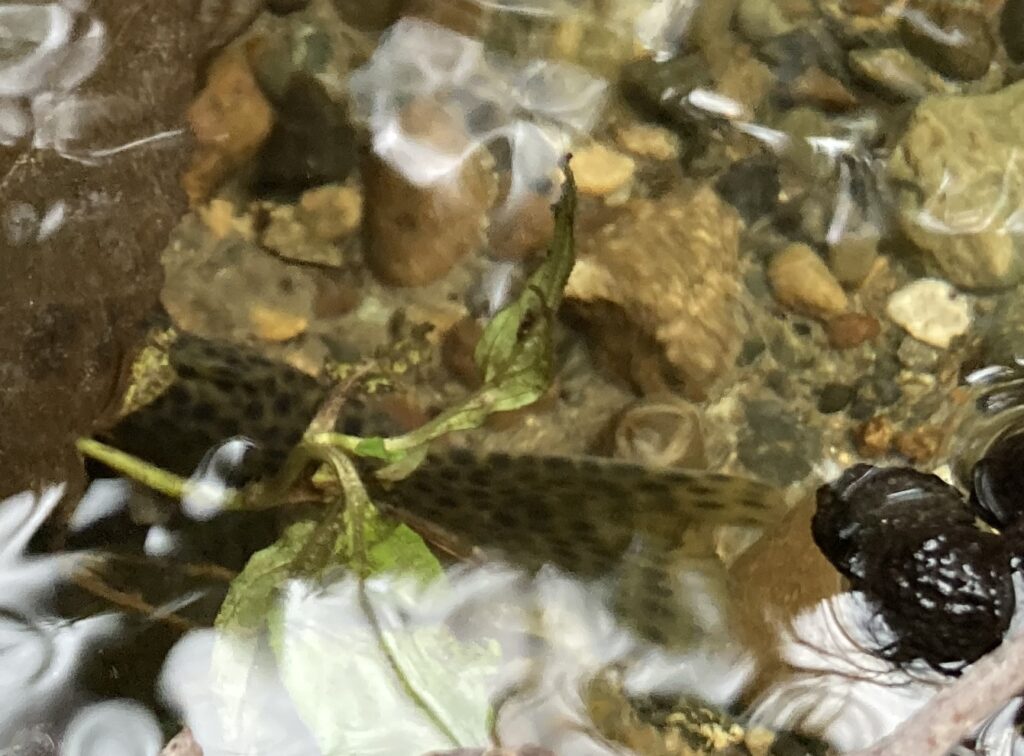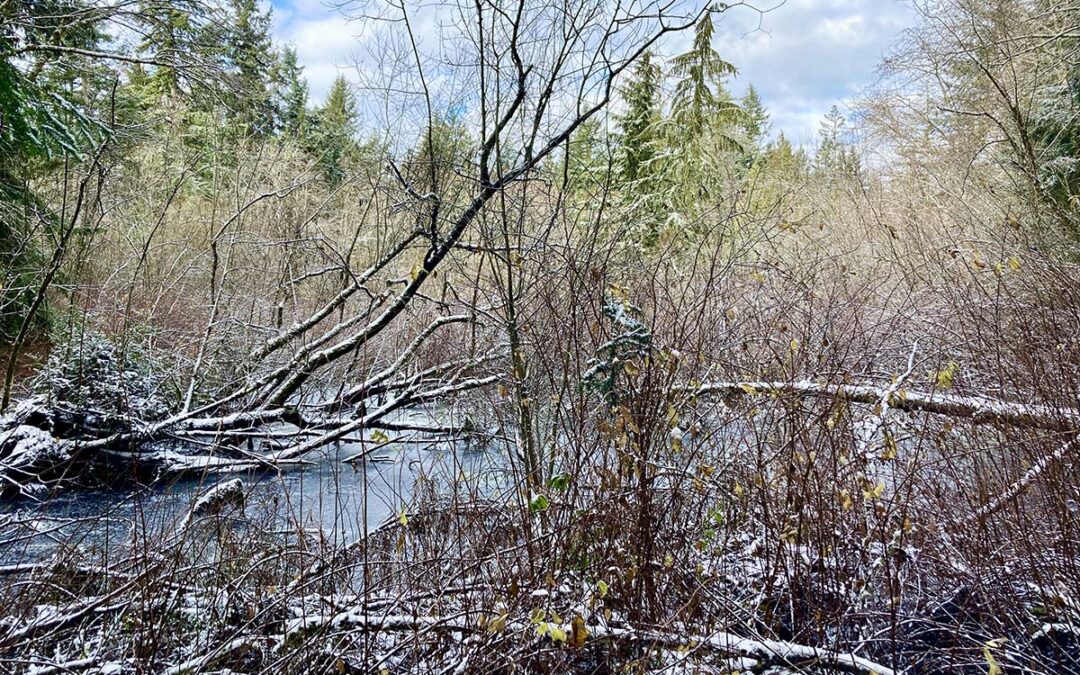The headwaters of Christensen Creek, Christensen Pond. Credit: Bianca Perla
Just before winter solstice, Vashon Nature Center co-director Bianca Perla visited her salmon-watch reach to both look for fish and find her calm center amid the holiday bustle. As she walked along a stretch of Christensen Creek she has surveyed each winter for the past 10 years, she felt the slight change in atmosphere she often notices before encountering something unexpected in nature.
“I saw a fin above the water and at first, I thought, ‘Wow, a coho made it up this far,’ because the water wasn’t too deep,” Perla says. “But when I got closer, I could see there were two fish kind of bumping against each other. Then one of them darted off into a clear pool to the side, and I could see spots all over it.”
She recognized the spotted pattern as a cutthroat trout, but the size was surprising. She regularly sees 2-4-inch-long resident cutthroat in this creek, but one of this pair was 12 inches long and the other nearly 18 inches.

“I was so excited when I realized these were spawning sea-run cutthroat trout, and it was a wonderful gift at that time of year. The solstice is like the new year to me when the light starts coming back and portends new growth,” Perla says. “I knew there were cutthroat trout in Christensen because I’d seen smaller ones, but I didn’t know if sea-run cutthroat were still using it until I saw these two—nobody has witnessed sea-run cutthroat spawning there for a very long time. It was poignant to see them bringing a new generation of life into the creek.”
Unlike fellow salmonids coho and chum, cutthroat trout live in island streams year-round. The cutthroat has two forms: landlocked and anadromous (or ocean migrating)—and though their lifestyles differ dramatically, they are the same species. (Similarly, steelhead are the sea-run version of rainbow trout.) Both these trout species are iteroparous, meaning they can spawn more than once, unlike Pacific salmon species like chum and coho, which die after spawning once.
After hatching, cutthroat either stay in the stream permanently (resident cutthroat trout) or head to saltwater where they live before returning to their natal stream to spawn (sea-run cutthroat trout). The sea-run cutthroat lifecycle involves the fish spawning in creeks—generally from February to May—then regaining their strength in estuaries before returning to Puget Sound where they live before spawning again. Though sea-run cutthroat regularly spawned 4−5 times over 7−8 years a decade ago, recent studies show these fish are now only spawning once, largely due to the loss of the estuarine habitat they need to rejuvenate before returning to the Sound.
“A lot of attention has been paid to our bigger salmon species, because they are so much a part of our economy and culture here, but the sea-run cutthroats are like a younger sibling that never gets the limelight,” Perla adds. “They’re incredibly important components of our stream systems, and they serve a lot of similar functions to other salmon, like bringing ocean-derived nutrients back to our forests.”
““I consider them to be the island salmonid,” says Rayna Holtz, longtime salmon watcher and island naturalist who has surveyed island streams for years. “Cutthroat are the most widespread salmonid on the island and they live in our creeks year-round.” It may come as a surprise to many islanders that cutthroat trout have been documented in 20 of the more than 75 creeks surveyed on Vashon. Creeks include: McCormick, Baldwin, Shinglemill, Ober, Robinwood, Christensen, Bates, Paradise Cove, Tahlequah, Shawnee, Fisher, Judd, Tsugwalla, Raab’s, Ellis, Gorsuch, Dilworth. Mileta, Ellisport, and Beall. For more information on streams that have been surveyed explore this interactive map from Wild Fish Conservancy or this table summarizing salmonid records from a variety of reports.

“We call sea-run cutthroat the apex predator of the super shallow nearshore,” says James Losee, regional fish program manager, Region 6, Washington State Department of Fish and Wildlife (WDFW). “They occupy the margins of the marine environment, hanging out along shallow beaches with the clams and barnacles—areas where otters, seals, and sea lions aren’t. They fill an important niche in the ecosystem as predators helping to help control disease and balance the food web.” https://coastalcutthroatcoalition.com/
Another notable fact is that cutthroat distribution along the West Coast perfectly overlays with temperate rainforests—you won’t find them anywhere else.
“They’re really important to our coastal rainforest ecosystem,” Losee says. “They have an interconnected role with chum salmon—they feed heavily on chum flesh, and eggs, and fry. And a lot of terrestrial and avian predators feed on cutthroat.”
“WDFW manages five species of Pacific salmon, steelhead, and all the other fish and commercial fisheries, and that doesn’t leave many resources to think about cutthroat trout,” he adds. “We really know very little about them and that’s kind of sad, but also an exciting place to be as a scientist.”
Losee helped form the Coastal Cutthroat Coalition to bring scientists, tribes, anglers, and the community together around the science and management of sea-run cutthroat trout. He relies on volunteer community scientists for intel on cutthroat, just as Vashon Salmon Watchers have been essential to gathering island chum and coho knowledge.
All the data in a groundbreaking paper Losee co-authored in 2016 about sea-run cutthroat redd timing and structure were collected by volunteers. Here on Vashon, you can add to our cutthroat knowledge by becoming a salmon watcher, or simply quietly watching a local stream, especially in the peak spawning period in February and March.
Losee notes that sea-run cutthroat are sneaky when spawning, so people looking for them must be equally stealthy. These fish like streams with overhanging vegetation and shade where the flow of the water is slow—about half a person’s normal walking speed. Their preferred water depth is typically less than three feet, and they generally make redds in areas with slightly bigger than pea-sized streambed gravel.
Salmon-watch Coordinator Kelly Keenan was surprised to find a pair of sea-run cutthroat spawning under the Shinglemill Creek Cedarhurst culvert several years ago. She has always hated to see the salmon-watching season end just as the sea-run cutthroat season is beginning. Keenan hopes islanders will be inspired to explore their nearest creek to increase the possibility of more local sea-run sightings. If you find spawning trout, please take a photo and fill out this Vashon Nature Center contact form with the location, date, and time.
“Seeing trout spawning in Christensen gives me deep admiration for the tenacity of these fish—and it gives me hope,” Perla says. “Environmental news can be depressing, but what isn’t said is that Earth is a powerful system, and there are all these interconnections working towards health. Sometimes if we change a few things to create better conditions, nature will take it the rest of the way.”
Sign up for the Vashon Nature Center newsletter for announcements about volunteer opportunities, including salmon watching.


Thrilled to see this spotlight and work. However this comment concerns me:
Humans also find them tasty — cutthroat are a favorite fish among anglers.
This is solely a catch & release fishery. Perhaps prized Vs tasty?? Protection is key Vs salivating
Hi Neil–Thanks for your comment. Let me check into this and I’ll get back with more info. It was my understanding that they can be harvested for food in season with a permit.
Hi Neil–I just learned that only the resident form of cutthroat can be harvested for consumption. I will edit this out of the article to avoid confusing. Thanks very much for pointing this out!